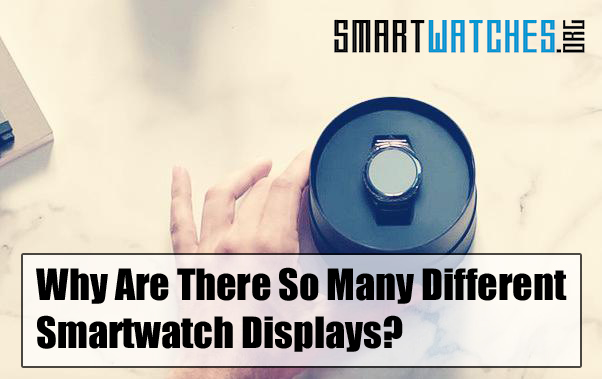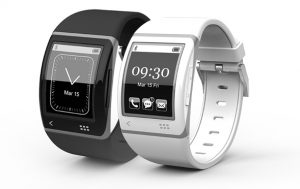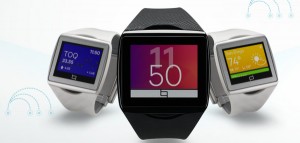Have you noticed there are many types of smartwatch displays? Ever wonder why?
Smartwatches are like smartphones when it comes to display types. There are many kinds of smartwatch displays, each with their own benefits and weaknesses. Some displays even have specific functionality or features that others don’t.
The answer is simple. There are so many smartwatch displays because each consumer wants something different. And each manufacturer that launches a product wants to be different than their rivals.
This encourages engineers and manufacturers to evolve the technology.

What Kind of Smartwatch Displays Are There?

There are two main smartwatch displays on the market. Many more exist, and in the future more will crop up but these two technologies are the most relevant for now.
The first is a touchscreen display like you find on modern smartphones. A touchscreen offers bright and vivid colors at the expense of increased battery consumption. Touchscreen displays use more power, and rarely allow for continuous use. So, most smartwatches that have a touchscreen won’t have an always-on mode. That’s a shame because you should be able to see the time on any watch without turning on the screen.
The second display type uses e-ink or grey scale elements. The main benefit of e-ink smartwatch displays is that they use little power. They can remain on for longer periods of time.
Even with grey scale colors the display can have vivid qualities. One of the biggest weaknesses with them is they don’t have touchscreen functionality. This means you must navigate the UI via physical buttons like a traditional watch.
Now, a lot of this information is being generalized. So, you may find e-ink on touchscreens, and advanced displays with an always-on feature. It just depends on the model and manufacturer.
Which Smartwatch Displays Are Better?
As with most tech, the “best” smartwatch displays depend on what you want your smartwatches to do.
 For instance, if you want a traditional watch that will always display the time then choosing one with an e-ink display is the way to go.
For instance, if you want a traditional watch that will always display the time then choosing one with an e-ink display is the way to go.
The Qualcomm Toq features an always-on display that’s actually in color. The Toq achieves this thanks to a proprietary technology designed by Qualcomm. It’s far from standard.
The Toq is much harder to find now because it’s an older, discontinued smartwatch.
If you hate grey scale or black and white colors then touchscreen displays are the way to go. Touchscreen based UIs are also easier to navigate than those that rely on physical buttons, at least when it comes to smartwatches.
Is One Display Type More Expensive?
Display type doesn’t affect the cost of a device. Some devices with e-ink displays are expensive and some devices with touchscreen displays are cheap, it just depends.
The price reflects the make and brand more than the actual functionality offered, which is true of most product markets.
The Pebble retails for around $150 while the Samsung Galaxy Gear retails for around $300. The odd part is the Pebble has more functionality, and the Galaxy Gear is only compatible with select Samsung smartphones.
The Pebble uses an e-ink type display while the Galaxy Gear uses a touchscreen. The Sony Smartwatch 2, which is also equipped with a color touchscreen display retails for about $150-200 like the Pebble.
So, as you can see, it just depends on the model.
Why Do Touchscreen Smartwatch Displays Seem To Have More Functionality?
It only seems that way.
Believe it or not, there are a few e-ink devices that offer a wide variety of features. You can install apps on the Pebble even though it doesn’t have a touchscreen display.
The Sonostar is another example of a device with an e-ink display that offers a lot of features.
Don’t fall into the trap of thinking one display type is better than the other, because they both have strengths and weaknesses.
No matter which display type you prefer, you won’t miss out on certain features either. Functionality is limited by the device itself instead of the display.
I Don’t Like the Smartwatch Displays That Are Available, Will There Be Others?
Of course! It is going to take more time before companies perfect the ideal smartwatch model. Eventually, smartwatches will evolve to be more effective and more powerful.
One of the most prominent issues with any mobile device is battery life. That’s even more prevalent with smartwatches, because if the battery dies you can no longer do even simple tasks like check the time. When that happens the device becomes nothing more than a paperweight.
Why all this talk about battery life?
It’s because the display is one of the most power hungry components of any device. In the future, this balance will be perfected so displays use less power yet still offer a good amount of functionality.
What Smartwatch Displays Are Better for Battery Life?
I addressed this question above, but if you’re looking for longer battery life than e-ink displays are the best option.
Expect to see decreased battery life with touchscreen displays because of the extra power they need to operate. This is not true of all touchscreen devices, but the ones with longer battery life are the exception not the rule.
Qualcomm created a proprietary technology for their watch the Toq. That is why it boasts increased battery life even with a color display.
Pebble has one of the longest lasting batteries in the industry, at least right now. Maybe that will change.
Original Featured Image Credit: Samsung Newsroom via VisualHunt.com / CC BY-NC-SA
